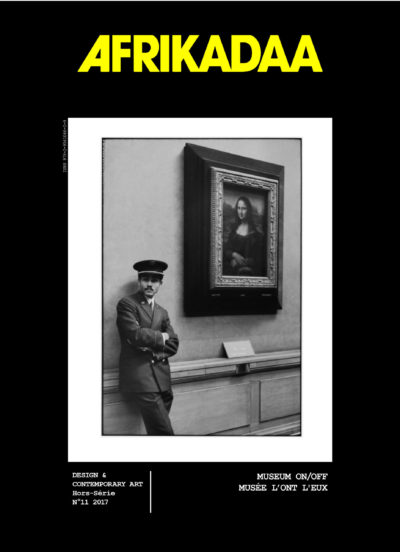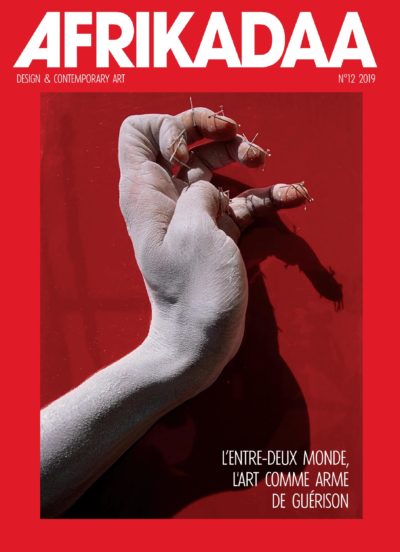Ce numéro d’Afrikadaa fait le point sur plusieurs formes d’art qui révèlent toutes la dynamique du corps et ses transformations. Pour ce numéro, La revue Afrikadaa va transformer son espace en un corps medium. À l’évidence, le corps est le grand terrain d’exploration de différents médiums artistiques du XXIe siècle. À force, il en est devenu un thème fédérateur. C’est l’outil de création par excellence. La revue Afrikadaa, en tant que médium de la même espèce, prend aujourd’hui le temps d’y réfléchir.
Il s’agit pour nous de privilégier une analyse capable non seulement de mettre à jour l’inscription du corps dans le médium artistique, mais également de rendre compte de leurs interactions. Le corps est envisagé tout autant comme incarnation concrète que comme idéologie. Certaines pratiques artistiques appréhendent l’autre comme une présence dématérialisée.
Dans ce cas d’espèce, l’incarnation ne passe plus nécessairement par le corps.
Ce bouleversement entraîne une quantité d’autres. En littérature, par exemple. Que dire du corps qui se fait « signature » d’un personnage? Quels sont les enjeux du corps pour la construction de l’individu? Dans les arts visuels les questions se posent dans les mêmes termes. Comment l’art prend-il en charge la disparition des corps? Nombre d’images aujourd’hui nous montrent un corps retravaillé, manipulé, objectivé. Jouant avec les codes du genre, les arts explorent la question de l’identité.
Comment le physique participe-t-il de la construction de l’identité ? Y a-t-il un « excès » de corps? Quels sont les enjeux d’un corps déconstruit par l’œuvre d’art, comme dans le corps colonial de Frantz Fanon?
Chez Fanon, le Noir rêve d’être blanc, mais de quoi rêve le colonisé ? D’être à la place du colonisateur, comme l’explique en substance Stuart Hall : le regard du colonisateur sur le colonisé est celui du désir, de la reconnaissance. Quand on parle du corps colonial, il faut bien sûr entendre le corps du maître, la chair du maître (à la manière dont l’entend Dany Laferrière) qui, seul, à prétention à exister et, par là, cherche sans cesse à décontextualiser celui du colonisé, cette victime désirante.
C’est à travers le corps colonisé que jouit le colonisateur, lequel corps met son pouvoir en valeur. Là repose l’ambiguïté de la dialectique du colonisé et du colonisateur : le corps du noir n’existe pas sans celui du blanc. Peut-on encore parler du corps noir-corps-chose après Le Code Noir de 1685 ? Ce corps mutilé, morcelé comme le dit Joseph Conrad dans « Au cœur des ténèbres », devient le corps désir, le corps où s’articulent de nombreux fantasmes.
L’art contemporain africain est le lieu de surgissement d’un corps éclaté, débordant et redéfini comme le corps de l’autre, objet de désir et de jouissance.
Le discours de la revue est à l’aune de l’incarnation : une parfaite résonance avec le présent.
 ENGLISH VERSION
ENGLISH VERSION
This issue of Afrikadaa draws from art of many genres to reveal the dynamics of the body and its transformations. For this issue, afrikadaa magazine will transform its space into a medium body.
As is known, in the 21st century the body has been a significant site for exploration in a variety of artistic media. It is the tool of creation par excellence. It is for this reason that we have taken it as an organizing theme and created a space to reflect upon it.
We are concerned with privileging analysis that is not only capable of bringing to light the inscription of the body in artistic media, but also which take into consideration interactions between the body and media. The body is a concrete incarnation as much as an ideology— or, at the very least, an aid to the expression of ideas and theories. Indeed, certain artistic practices apprehend the other as a dematerialized presence. In these particular cases, the incarnation no longer passes through the body.
This disruption brings about a multitude of others. In literature, for example, what might be said about the body that is made as a “signifier” for a character? What are the stakes for the body in the construction of the individual? In visual arts, these questions might be asked in the same terms. How does art take responsibility for the disappearance of the body? How does it give presence to the body’s absence?
Many contemporary images show us a body that has been reworked, manipulated, objectified. Playing with codes—sex, race, religion, etc.— this art explores questions of identity. How is the physical a part of identity construction? Is there corporeal “excess”? What are the stakes of a body that has been deconstructed by a work of art? When the body is made of physical material, what might learned with the sense of touch?
Why is the body the vehicle for artistic work? What might we say about the body that is the “medium” or the “screen” of the work? What might be said about the body as spectacle?
Taking into account social discourse, the body is also something that receives art.
Let us consider the colonial body of Frantz Fanon. In Fanon, the black man dreams of being white, but what do the colonialized dream about? To be in the place of the colonizer, as Stuart Hall explains at length: the gaze of the colonizer upon the colonized is one of desire and recognition. When we speak of the colonial body, we must, of course, also understand the body of the master, the flesh of the master (as it is understood in Dany Laferrière’s 1997 The Flesh of the Master), which, alone, has existence as its objective. In this way it seeks to decontextualize the colonialized, the desired/desirable victim ad infinitum. The colonizer receives pleasure upon the body of the colonized, and he depends upon the colonized body for power and worth. Therein rests the ambiguity of the dialectic between the colonized and the colonizer. The black body does not exist without the white. Can we even speak of the black-body-object after Le Code Noir of 1685? This mutilated body, cut into pieces as in Joseph Conrad’s Heart of Darkness (1925), becomes the body-desire, the site where manifold fantasies are articulated.
The resurging body, exploded, overflowing and redefined as the body of the other, an object of desire and pleasure, is manifest in contemporary African art.
In light of this incarnation, we are in perfect resonance with the present.
Contributeurs : Jay One Ramier, Holly Bass, Malick Ndiaye, Deborah Willis, Wangechi Mutu, Alanna Lockward, Diane Chavelet, Gastineau Massamba, Karen McKinnon, Maria Magdalena Campos-Pons, Shireen Hassim, BOMB Magazine, Eva Barois de Caevel, Malam, Dominique Malaquais, Bill Kouélany, Les Ateliers Sahm, Job Olivier Ikama, Kemi Ilesanmi, Landromate Project, Zanele Muholi, Nandipha Mntambo, Lebohang Tlali, Stevenson Gallery, Holly Bass, Lynette Yiadom-Boakye, Martina Bacigalupo, Gustave Mambo, Aissata Pinto da Costa, Arnaud Cimetière, Sylvie Kande, Steve-Régis « Kovo » N’Sondé, Maï Lucas, Papy Maurice Mbwiti, Céline kamadaye, Virginie Echene, Melanie Spears Harper, Amina Zoubir, Eric Hahounou, Senga Nengudi, Galerie Anne de Villepoix.
par Pascale Obolo et Frieda Ekotto





Avis
Il n’y a pas encore d’avis.